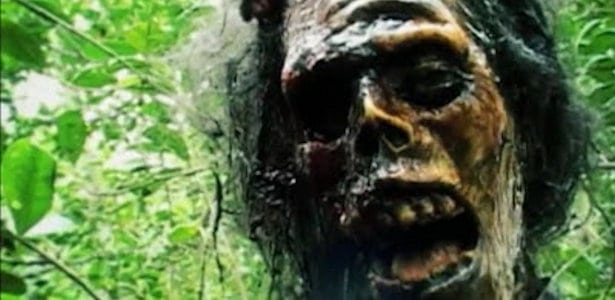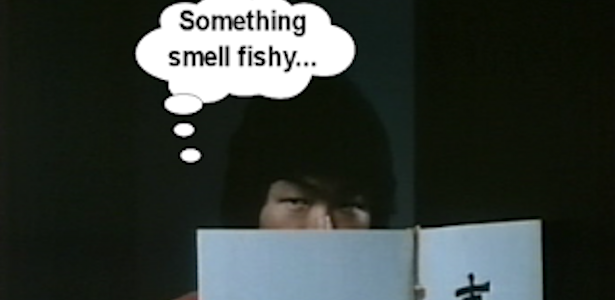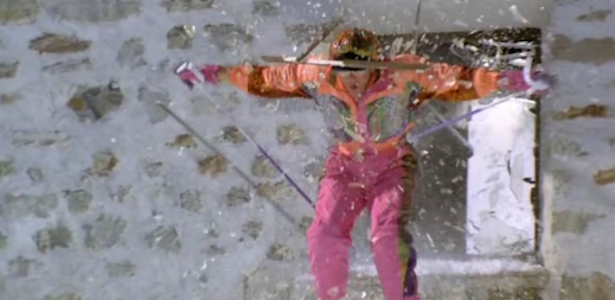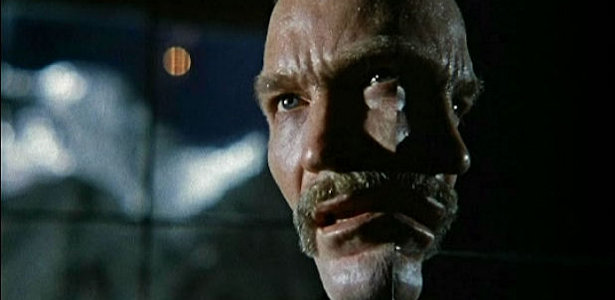My “A #1” Rule of Movie Making: Everything is cooler if set in the future. I’m not talking about that “thinking man’s science fiction” stuff either. Not that I think that sort of thing is bad, I mean, CHILDREN OF MEN (2006) was cool and all, but the future? Nah, I ain’t buyin’ it. More like the hyper-present. Nope, in my book the future isn’t just changing out the billboards for giant plasma monitors (psssh, like we’d even have billboards in the future!), for my money the future is neon-lit monorails, cars that drive themselves, computers with toggle-switches and big incandescent bulb-lit plastic buttons, and robots! Robots are totally the future, right? Now if you add in secret agents with blow-dried hair, blazers with the sleeves pushed up to the elbows, and giant, clunky laser weapons, what do you have? You have CONDOR!
 |
| Nice cannons on that deck! |
Set in the most futuristic date ever, 1999, Los Angeles is now a thriving metropolis that, well, seems exactly the same as it did in 1986, except that it finally got that monorail system that they decided was such a stupid idea back in the ‘70s. This apparently alleviates a lot of the traffic and light traffic in L.A.? Man, that is totally sci-fi!
Ray Wise is Christopher Proctor, one of the top agents for a Los Angeles based FBI/CIA hybrid organization named Condor (nope, that’s not an acronym for anything) who thwarts evil-doers foreign and domestic. Sort of a Department of Homeland Security, except presumably without the civil rights violations. Proctor (who appears to have broken into Don Johnson’s wardrobe trailer) has just returned from an assignment in Singapore where he lost his partner of unspecified sex who was “more than a partner, a whole lot more”. This is of course after he turns down an advance by a busty hottie at the local fast-food outlet Pirate Pete’s, telling her “sorry, you are not my type”. Damn, but she is built! Out of hydraulic piston technology, that is! Perhaps he knew that when he turned her down. The troubling thing about this scene is not that Proctor has no appreciation for the siren’s lure, but that we never see what it is he got from this land-locked ship. Do they serve sustainably farmed fish n' organic, fat-free, low-carb, unfried chips? Or is it rat on a stick? This important detail must have been lost to time constraints, I’m sure of it.
Upon arriving at “the office”, a giant MIB-style mega-emporium of officiousness, Proctor’s boss Cyrus Hampton (Craig Stevens), introduces Proctor to his new secretary. Says Proctor “you sure know how to hire good looking assistants!” Nope, says the boss, it’s your new partner! What?! It’s a girl, partner? Ewwwww! Jeeezus dude, nobody’s asking you to marry her, fer cryin’ out loud. Not only is it bad enough that she’s a she, but after losing an arm-wrestling contest (what, no Indian burns and wedgies?), poor Proctor discovers that she is a girl robot partner! As Cyrus explains it, Lisa (Wendy Kilbourne) is a new type of robot, one that is a “molecular computer” that uses no binary logic, but instead is composed of new-fangled bio chips that emit enzyme producing bacteria that allows her to function as a human instead of being hamstrung by the on/off system of normal computers. Yeah, ok, that’s more of an explanation than I ever got from a Schwarzenegger movie, so I'll go with that.
 There’s no time to cause any more gender-biased fuss, Cyrus needs the duo to go after high-tech criminal/terrorist The Black Widow (Carolyn Seymour) who has escaped from a high-tech, robot patrolled prison with the aid of a GHOSTBUSTERS ecto-detector and James Bond’s jetpack from THUNDERBALL. No, seriously. How she got this stuff into the slam is anyone’s guess, but what she’s up to is no mystery. Incarcerated for infiltrating and stealing the Pentagon’s super-secret “Vanguard Code” which gives anyone who possesses it in their memory free access to America’s defense arsenal, Black Widow plans on holding the country hostage for one miiiiiilion dollars! Well, actually she wants 25 million dollars, safe passage out of the US and Agent Proctor delivered alive so she can exact her vengeance for the death of her brother. As a demonstration of her power, she has hacked into the police computer system and has used her knowledge of the Vanguard Code to use the police’s BLUE THUNDER-esque chopper drones to attack an L.A. powerplant. Man, she sure knows how to kick L.A. in the jimmy! The only thing worse would have been the water reservoir, but it would have made for a far less dramatic explosion, I suppose.
There’s no time to cause any more gender-biased fuss, Cyrus needs the duo to go after high-tech criminal/terrorist The Black Widow (Carolyn Seymour) who has escaped from a high-tech, robot patrolled prison with the aid of a GHOSTBUSTERS ecto-detector and James Bond’s jetpack from THUNDERBALL. No, seriously. How she got this stuff into the slam is anyone’s guess, but what she’s up to is no mystery. Incarcerated for infiltrating and stealing the Pentagon’s super-secret “Vanguard Code” which gives anyone who possesses it in their memory free access to America’s defense arsenal, Black Widow plans on holding the country hostage for one miiiiiilion dollars! Well, actually she wants 25 million dollars, safe passage out of the US and Agent Proctor delivered alive so she can exact her vengeance for the death of her brother. As a demonstration of her power, she has hacked into the police computer system and has used her knowledge of the Vanguard Code to use the police’s BLUE THUNDER-esque chopper drones to attack an L.A. powerplant. Man, she sure knows how to kick L.A. in the jimmy! The only thing worse would have been the water reservoir, but it would have made for a far less dramatic explosion, I suppose.
Written by veteran Saturday morning cartoon writers Len Janson and Chuck Menville, and directed by Virgil W. Vogel, a veteran of every damn '80s TV show ever (including “Magnum P.I.”, “MacGuyver”, “Hardball” and “Tales of the Gold Monkey”), this movie feels like it should have been an animated feature in the vein of STARCHASER (1985). In spite of an obvious lack of budget, this movie really tries to put as much future craziness up on the screen as possible, throwing wacky futurisms out with abandon and delivering it all at a breakneck speed and a scant 73 minute running time. Add plenty of cheap action (including electric-car chases), lasergun shoot-outs, amazingly campy dialogue and a great cast (including a cigar-chomping Vic Polizos and martial arts wielding James Avery) make this an absolute blast. The only downer is that I would have loved to see what this could have been as a feature film. The mind boggles.
 |
| Nice sheets dude. Is that a racecar bed? |
Things I learned about the future from watching CONDOR:
– In the future police robots must use wristwatch communicators to make voice calls for back up.
– In the future cars will have on-board dash computers composed of a CRT with toggle switches and big plastic buttons.
– In the future people will drive wood-paneled mini-vans.
– In the future assassins will still wear Gargoyles.
– In the future top government agents will have ID cards made of plain, typewritten paper.
– In the future an appropriate name for a cat will be “Virgil”.
– In the future people use hologram-projectors to watch obese women in plastic Viking outfits sing Wagner.
– In the future government computers render 3D worse than a freakin’ Playstation, but at least have anti-aliasing software.































































